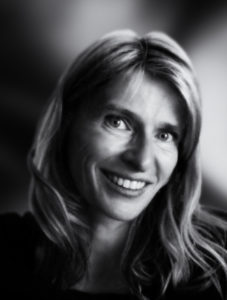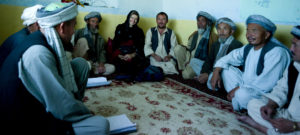
Monika Bulaj is an award-winning photojournalist, reporter, documentary film-maker, based in Italy. Her work on minorities at risk, nomads, faiths and shared sacredness in Eastern Europe, the Middle East, the Caucasus, Central Asia, Africa, and Caribbean, has been recognized by The Aftermath Project Grant, Leonian Award & W. Eugene Smith Memorial Fund, TED Fellowship, Bruce Chatwin Special Award, Grant in Visual Arts from the European Association for Jewish Culture, and other awards and nominations. She has studied Polish Philology at the University of Warsaw, and also anthropology, philosophy, theology. She speaks eight languages.
Bulaj’s work has appeared in The Guardian, Granta Magazine, National Geographic, The New York Times, TIME, Courier International, RevueXXI, La Repubblica, Corriere della Sera, Al Jazeera, and GEO, among others. She has published 10 books, the latest being Nur. Afghan Diaries with National Geographic (in Polish) and Where Gods Whisper, with Contrasto (in English and Italian). She has displayed her work in more than 90 personal exhibitions around the world.
Bulaj was the first women to receive the Italian National NonViolence Award “for her work as a photographer, reporter, and documentary-maker which sheds lights on humanity living in the most hidden yet most evident boundaries on earth, for showing war through its consequences, for investigating mankind’s soul, our eagerness for religiosity, tenderness, and dignity. Bulaj makes the invisible visible by exploring people’s soul, by uniting humanity in an image.”
Monika acts in a “performing reportage” at the theatre, as storyteller: Where Gods Whisper, Broken Songlines, Sacrum in figura, Far from where, Kabul night, Invisible geographies, Auras, Sacred Crossings, with images , films, sounds, songs and stories written by her. She is teacher of photography, street theater, and dance on stilts, for children in ghettos or at-risk communities. She travels across Europe with her lectures: hosted by universities, art festivals, global conferences and small villages. Monika collaborates for many radios as well, both in Poland and in Italy, and with TV, for Repubblica TV and for Rai TV Educational. She has realized a documentary movie: “Noah’s Sons” in Azerbaijan, and has screen-written documentaries, among which the movie “Romani Rat” on the Holocaust of the Roms, where she had also a leading role and was a storyteller.
CONTACT
Photojournalistic assignments, lectio magistralis and academic conferences, exhibitions, shows performing reportage, teaching and curating, fine art prints: monikabulaj(at)gmail.com
BOOKS
• Geografie sommerse (print: EBS, Italy 2023, in Italian)
• Where Gods Whisper/Dove gli dei si parlano (Contrasto, Italy 2017, in English and Italian)
• Nur. Zapiski afgańskie/Nur. Afgan Notes (National Geographic, Poland 2017)
• Nur. La luce nascosta dell’Afghanistan/Nur.The Hidden Light of Afghanistan (Electa Mondadori, Italy 2013)
• People of God, a Travel into Another Europe (Postcart, Italy 2012)
• Boży ludzie. Podróż po kres Europy/People of God, a Travel into Another Europe (BOSZ, Poland 2009)
• People of God, a Travel into Another Europe (Frassinelli, Italy 2008)
• Rebecca e la pioggia/Rebecca and the Rain (Frassinelli Italy 2007)
• Figli di Noè/Sons of Noah (Frassinelli Italy 2006)
• Gerusalemme perduta/Jerusalem Lost, with Paolo Rumiz (Frassinelli Italy 2005)
• Women, stories (Alinari Italy 2004)
• Libya Felix (Bruno Mondadori 2002)
and others books and catalogues
MOST NOTABLE AWARDS, GRANTS AND NOMINATIONS
• The Leica International Society 2022 grant winner, Ireland
• Premio Montale Fuori di Casa, Sezione Giornalismo Fotografico, 2022, Italy
• Nomination for the Luxembourg Art Price 2021
• Nomination for National Geographic Society’s Storytelling Fellowship, USA 2020
•Travel grant from Pulitzer Center on Crisis Reporting, USA 2019
•Virginia Quarterly Review Prize for Photography, USA 2019
• Leonian Award/ W. Eugene Smith grant in Humanistic Photography, USA 2018
• Nomination for the Prix Carmignac ‘The Amazon’ 2018
• Nomination for Award ANI – PixPalace 2016
• Nomination for Visa d’Or Daily Press 2015
• The National Non Violence Award 2014 (First woman to be given this award)
• Catchlight, the honourable mention in the Professional Category 2014
• Premio Città di Trieste al Reportage 2012
• Tomizza award 2012
• Nomination for Beata Pawlak Award 2011
• Lucchetta Grant 2011
• TEDGlobal Fellowship 2011
• The Aftermath Project Grant Winner 2010
• Bruce Chatwin Special Award for Photography “Absolute Eyes” 2009
• Grant in Visual Arts sponsored by the European Association for Jewish Culture 2005
EXHIBITIONS
2022-2023: In the shadow of the Baobab. Emergency and the beauty of the care. Milan and Venice and IMP-Festival -International Months of Photojournalism Padova, Italy
2022: Broken Songlines, Festival Fotografico Europeo, Busto Arsizio, Italy
2021: Broken Songlines, Fotografica, Bergamo, Italy
2020: Broken Songlines, Festival Isole che Parlano, Palau, Sardegna, Italy
2019: Broken Songlines, Festival della Fotografia Etica, Lodi, Italy.
2018: Nur. Afghan Diaries, Ancona Photo Festival, Italy.
2017: Where Gods Whisper/Sacred Crossings, Centre Européen de Création et de Production, France. Nur. Afghan Diaries, Reggia of Colorno and Exhibition for Emergency, Brescia, Italy. Eyes on Main Street, Wilson Outdoor Photo Festival, USA.
2016: Nur. Afghan Diaries, ANI Pixpalace Award, Paris. Sacred Crossings, The Grotowski Institute, Wrocław. Nur. Afghan Diaries, Lugano, Switzerland.
2015: Where Gods Whisper, Milano, Italy. Haiti of the Souls, Visa Pour l’Image, Perpignan, France.
2013: Auras, Assisi, Italy. Nur. The hidden light of Afghanistan, Paris.
2012: Target Afghanistan, the land beyond the war, Palazzo delle Esposizioni, Rome. People of God, Balkan and Caucasian Observatory, Trento. Nur. Afghan Diaries, Il salone degli Incanti, Trieste. Auras, Festival on The Move, Cortona, Italy. Gens du Dieu, Le voyage en Autre Europe, San Malò, France. People of God, Festival Poiesis, Fabriano, Italy. The meaning of life, Palazzo delle Esposizioni, Roma, National Geographic Italia. Through Our Lens: Photographers Reflect on Empowerment, 25 Central Park West Gallery, New York.
2011: Nur, Officine Fotografiche, Rome. Auras, Venice. Russia 2009, Saint Petersburg. Nur, Palazzo Ducale, Venice. Room 16: “Religions in Trieste” Centre de Cultura Contemporània de Barcelona, Barcelona.
2010: Auras, Villa Pomata, Sardinia, Italy.
2009: Auras, Castello di Otranto, Italy. Vertical Europe, Palazzo Ducale, Genoa. Elia’s Journey, Festival della Storia, Gorizia. The Reverse Gerund, Rubiera, Italy. Elia’s Journey, Jewish Museum, Trieste. People of God, Katholische Akademie in Bayern, Munchen, Germany.
2008: People of God, Galleria BelVedere, Milan. Auras, Sama Khana, Cairo, Egypt. Rebecca and the rain, Antichi Chiostri, Turin. Auras, Palazzo Blumenstihl-Istituto Polacco, Rome. Auras, ex Monastero dei Benedettini, Catania, Italy.
2007: People of God, World Social Agenda, Bolzano. Rebecca and the Rain, Verona and Genoa. People of God, Centro Candiani, Venice; Biblioteca Classense, Ravenna; Palazzo Ducale, Genoa. Rebecca and the Rain, Basilica di S. Petronio, Bologna.
2006: Sons of Noah, Porta Sant’Agostino, Bergamo. People of God, Palazzo Geremia, Trento.
2005: Women, stories, Palazzo Medici Riccardi, Florence. People of God, Italian Institute of Culture, Colonia. People of God, Asti. People of God, Museo Civico, Reggio Emilia. The Return on the Don, Strehler Theatre, Milan. Le ha ma la ya, Rome. People of God, Remembrance Day, Milan.
2004: People of God, Galleria Nazionale d’Umbria, Perugia. People of God, Teatro Sociale, Bergamo. Menschen Gottes, Langer Foundation, Bolzano. People of God, Europe and the Balkans International Network University of Bologna, Forlì. People of God, Polish Institute, Sofia, Bulgaria.
2003: People of God, Polish Institute, Budapest, Hungary.
2002: People of God, Polish Institute, Rome. Martinka gipsy and other stories, Turin.

One night, in the tavern, Wang-Fô shared Ling’s table. The old man had been drinking in order to better paint a drunkard, and he cocked his head to one side as if trying to measure the distance between his hand and his bowl. The rice wine undid the tongue of the taciturn craftsman, and that night Wang spoke as if silence were a wall and words the colors with which to cover it. Thanks to him, Ling got to know the beauty of the drunkards’ faces blurred by the vapors of hot drink, the brown splendor of the roasts unevenly brushed by tongues of fire, and the exquisite blush of wine stains strewn on the tablecloths like withered petals. A gust of wind broke the window: the downpour entered the room. Wang-Fô leaned out to make Ling admire the livid zebra stripes of lightning, and Ling, spellbound, stopped being afraid of storms. Marguerite Yourcenar, “Comment Wang-Fô fut sauvé”
